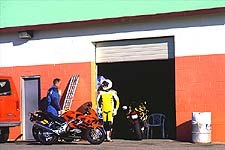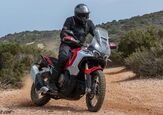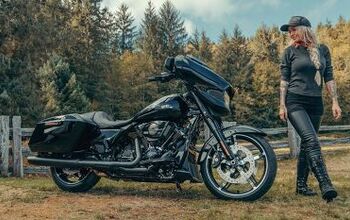
Get the Flash Player to see this player.
Los Angeles, April 12, 2000 -- Food is a funny thing. You can line up five chefs, give them all the same ingredients, and you'll end up with five different dishes. Motorcycles, it turns out, are much the same way.In this year's World Supersport shootout, three of the five bikes are completely unchanged from 1999, only one model has been revised, and only one model is included that was omitted before. Still, even with so many similarities, we came up with a completely different end result than what we had last year. That's what you get for having different chefs stir your pot.
We've gathered together the main contenders for the World Supersport title: four 600cc four-cylinder machines from Japan and one 748cc V-twin from Italy. All bikes compete head-to-head not only in what often turns out to be the most-competitive race of the weekend but also on showroom floors and back roads as more and more consumers opt for agility and light weight over a 130 horsepower motor pushing around a far more portly mass of semi-precious metals.
While Honda's CBR600F series motorcycles have generally been regarded as the best all-around 600-class machines made, Suzuki's GSX-R600 has long been the cream of the crop in racing circles. Last year Yamaha followed up its amazing YZF-R1 with the YZF-R6 that did to the 600-class what its big brother did to the liter-bike class. This year Kawasaki completely redesigned its ZX-6R in order to better compete with the rest of the 600 Supersports and, hopefully, secure the title for Team Green.
Where does the Ducati fit into all this madness, then? After all, can a bike that has an additional 150cc on its nearest competitor yet is still down on horsepower be taken seriously? Or is the chassis, which is almost identical to the all-conquering 996, enough to place the Ducati at the head of the class?
We went into this test with the goal of finding which machine is the absolute best all-around 600 Supersport motorcycle made. We took into account not only racetrack prowess, but also street-skills and drag strip times so that no matter what is your preferred domain, we hope to provide you with the info you need to chose the right mount.
Fifth Place: Ducati 748
The Ducati was in its element at the racetrack. Roland Sands, the 1998 AMA 250 GP Champion, said that no matter how fast he went on the 748 he felt like there was a whole other level of performance. Most testers agreed and said that no matter how fast they rode, the Ducati still had something left, even if they didn't. Despite this, the Ducati's average lap times were over one second per lap slower on average than all other bikes. This might have to do with the way the motor makes its power or the way the chassis prefers high cornering speeds instead of the more squared-off cornering line preferred by bikes with more power. Given enough track time, most riders would be able to alter their riding style and, on a tight track like the Streets of Willow, at least match the lap times of the Japanese fours.
Fourth Place: Suzuki GSX-R600
The Suzuki was a pleasant surprise. After making only 90 horsepower we expected the GSX-R to be slow on the track and at the drag strip. Even after so few changes over the past few years, the Suzuki's first few laps at the track had riders commenting on how "right" the bike felt. Roland Sands commented how he could "hold it open more than any other bike" in part because of the relatively mild power output, but also because of how stable and balanced the bike felt. Most testers generally spoke of the Suzuki within the context of a race track, noting how easy it was to ride fast.
Unfortunately, the GSX-R took a little trip to the infield infirmary, needing attention after Sands flicked the bike down the track, mid brain-fart, thinking he could do same things on the Suzuki as he does on his 250 GP bike. This wasn't good news for some testers who wanted more time on the bike, but it spoke volumes about how confident a rider became aboard the Suzuki. It also spoke volumes about Sands as his eyes looked like saucers when he realized we might have to pay for the damage. Roland, the bill is in the mail.
Third Place: Honda CBR-600F4
On the track the Honda exhibited the same characteristics as it did on the road. Most testers got up to speed quickest on the F4 and it drew comments such as: "If you're not an expert, this bike is the best choice." Lap times were typically one second per lap faster than the Ducati.
Second Place: Yamaha YZF-R6
Average lap times were in the neighborhood of one second faster per lap than any other bike, regardless of the rider. Both the brakes and the motor are strong while offering the amount of user-friendliness commonly found on less hard-edged motorcycles. The suspension has the same sort of balance that makes the Suzuki such a great track bike, but the R6 ups the ante with better components, more power and lighter weight for a sharper-edged package. While the R6 is designed for the experienced rider, even intermediate riders and novices may also appreciate the Yamaha's virtues.
At the drag strip we discovered another niche for the R6. While we expected the Kawasaki to rule while the R6 struggled with wheelies, we found that because the R6 had the most top-end power, it could pull out a good E.T. even if the launch was sub-par. The only problem we had
Even the clutch, which we expected to be fragile, lasted far longer than we expected, withstanding repeated full-throttle, clutch-slipping runs down the quarter-mile. It's nice to see that Yamaha, in their quest for ultimate performance, didn't sacrifice much if anything in the way of durability to eek out the last 100th of a percent of performance.
First Place: Kawasaki ZX-6R
Kawasakis have often been considered as horsepower bikes that tended to lack refinement. With its total make-over for 2000, the Kawasaki ZX-6R looked poised to trounce all-comers on the track just as it had on our dyno, posting an impressive run of 96 horsepower, tops in the lot above Honda's F4 (95.5 bhp) and Yamaha's R6 (93 bhp).
On the street the Kawasaki was our clear favorite. The fantastic motor made beautiful sounds and, matched to a smooth transmission, the upright-yet-still-sporty seating position made any sort of roadwork a
Once on the track, however, the ZX-6R showed that the changes made to the bike over the past year add up to more than just a higher MSRP. Without any changes to the stock suspension settings the front end felt fine, although the rear end moved around more than we would have liked. Because the bike turned well into the corners, we left the ride-height adjuster alone and increased the compression a few clicks. This helped settle things down, but the bike never quite attained that balanced feel of the 748 or the GSX-R600.
The Kawasaki's lap times were only a few clicks off of those posted by the R6 even though some testers felt they just couldn't get the suspension totally dialed in to their likings. The motor made good power off the bottom and that allowed the bike to attain high velocities down the following straight. Mid-corner the bike would touch down occasionally, though no hard parts dragged. In all, the ZX-6R is a tremendous all-around package.
Conclusion:
The Yamaha was a close second because it's such a kick-ass bike that makes you feel like a hero when you ride it. It's hard-edged (though not as much as the Ducati) and not bashful about it. A great bike for sure, but it lacks the ZX-6R's all-around usefulness. The same could be said about the Suzuki, but it's still toting around a few too many pounds and it needs an infusion of horsepower. That's OK though, we hear a new GSX-R600 is on the way for next year.
The Honda and the Ducati are exact opposites; most testers wished the Ducati had more of the CBR's user-friendliness and that the Honda was a bit more focused. We know, we're a tough bunch to please but when you're splitting hairs we can't be bashful, can we? And at the end of it all, we kept coming back to the ZX-6R. Different testers, a few changes and look at what happens to the pecking order in the Magic Kingdom of World Supersport.

Motorcycle.com presents an unrivaled combination of bike reviews and news written by industry experts
More by Motorcycle.com Staff









































Comments
Join the conversation